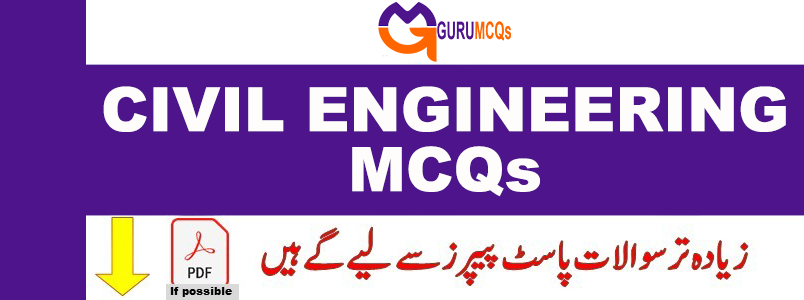
GURU MCQs provides Civil Engineering MCQs for Job Test and Interview Preparation, suitable for fresh graduates, students, and competitive exams. Most repeated civil engineering MCQs section is frequently encountered in CSS, PMS, Inspector, ASI, Sub-Inspector, Constable, FPSC, PPSC, ETEA, FIA, Police, Army, Navy, Airforce, IB, MOFA, ASF, LHC, Educators, and various other competitive exams, as well as government and private job assessments. The most common updated MCQs include Basic Civil Engineering, Building Materials, Surveying, Soil Mechanics and Foundation Engineering, Applied Mechanics, Hydraulics, Waste Water Engineering, RCC Structures Design, Irrigation, Railways, Construction Management, Theory of Structures, Estimating and Costing, Docks and Harbours, Elements of Remote Sensing, Building Construction, Concrete Technology, Advanced Surveying, Strength of Materials, Water Resources Engineering, Water Supply Engineering, Steel Structure Design, Highway Engineering, Airport Engineering, Structural Design Specifications, Tunnelling, and much more.
**141. The minimum grade of concrete used in the construction of RCC slab is:**
A. M10
B. M15
C. M20
D. M25
**142. The size of bricks should be generally taken as:**
A. 190 mm × 90 mm × 90 mm
B. 200 mm × 100 mm × 100 mm
C. 210 mm × 100 mm × 100 mm
D. 220 mm × 110 mm × 110 mm
**143. The term ‘FAT’ stands for:**
A. Fine Aggregate Test
B. Foundation Analysis Test
C. Field Acceptance Test
D. None of the above
**144. The presence of sulphates in water used for concrete mix may cause:**
A. Efflorescence
B. Corrosion of reinforcement
C. Increase in workability
D. None of the above
**145. In a simply supported slab, the bending moment is maximum at:**
A. Support
B. Mid-span
C. Quarter-span
D. Cantilever end
**146. The nominal size of the modular brick is:**
A. 190 mm × 90 mm × 90 mm
B. 200 mm × 100 mm × 100 mm
C. 210 mm × 100 mm × 100 mm
D. 220 mm × 110 mm × 110 mm
**147. The maximum water cement ratio for mild exposure conditions as per IS code is:**
A. 0.30
B. 0.40
C. 0.50
D. 0.60
**148. The minimum diameter of reinforcement bar used in slab should be:**
A. 6 mm
B. 8 mm
C. 10 mm
D. 12 mm
**149. The minimum thickness of plastering on external wall should be:**
A. 10 mm
B. 15 mm
C. 20 mm
D. 25 mm
**150. The purpose of providing d.p.c. is to:**
A. Prevent dampness from rising
B. Prevent attack from insects
C. Prevent attack from termites
D. All of the above

Pingback: Software Engineering MCQs for Preparation - GURU MCQS